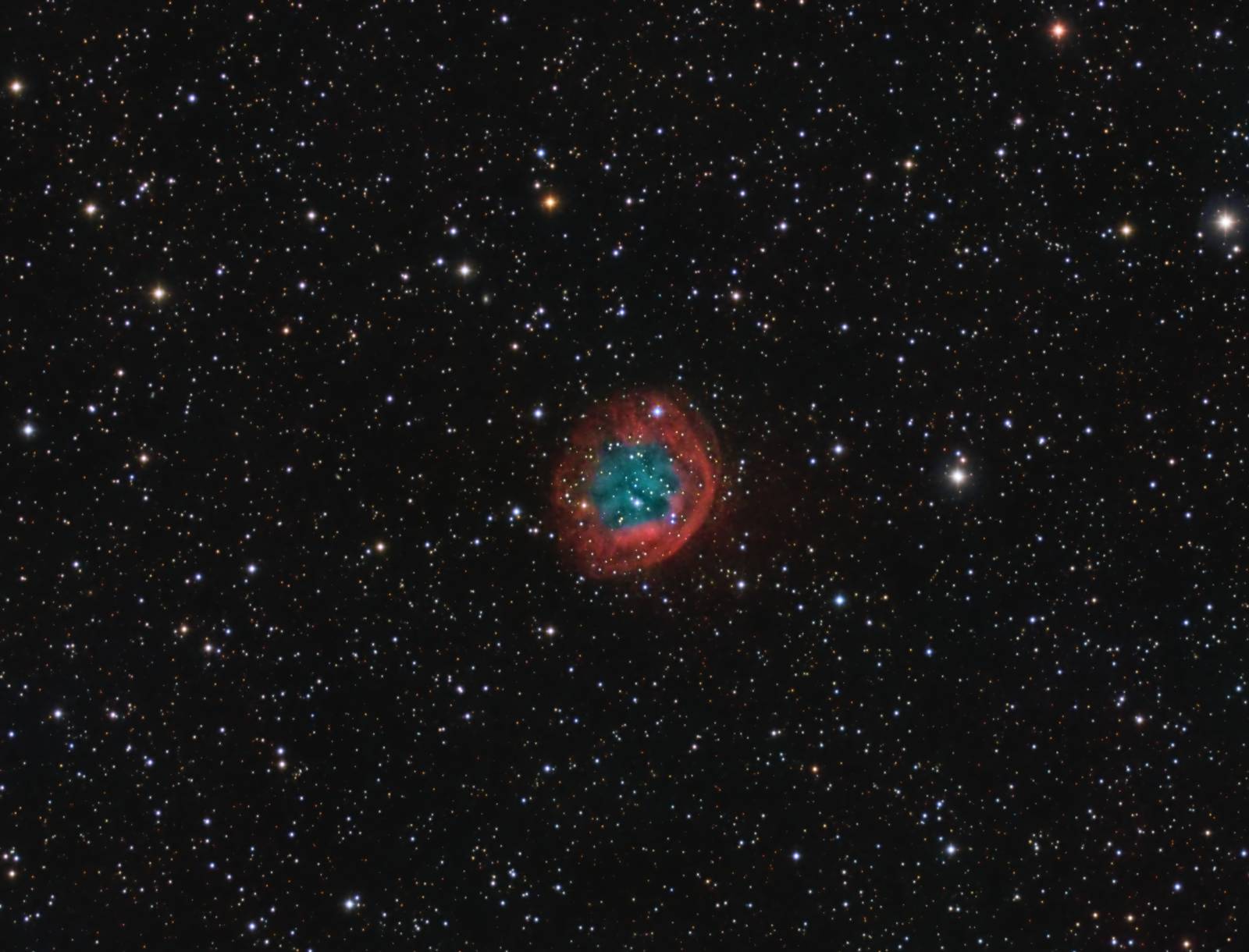Sharpless 290, Planetary Nebula
 Click image for full size version
Click image for full size version
April 26, 2017
Sharpless 221 (Sh2-290) is a planetary nebula in Gemini. It is also known as Abell 31 and PK 219 +31. Its diameter appears about half the Moon’s and it is located about 2,000 light years away. It’s true diameter is around 23 light years. The structures visible in this image are dominated by emissions from hydrogen (red) and oxygen (teal). This nebula is moving through space, with the leading edge — the sharper edge, on the right — interacting with the interstellar medium. This object is extremely faint, and was a challenge to process even though I collected more than 21 hours of data.
Tekkies:
Moravian G3-16200 EC camera (on loan from O’Telescope), Optolong Ha, O3, R, G and B filters, Takahashi FSQ-106 ED IV at f/3.6, Paramount MX, QHY5 guide camera, 175mm f.l. guide scope. Acquisition with the SkyX, focused with FocusMax. All pre-processing and processing in PixInsight. Acquired from my SkyShed in Guelph. No moon for Ha and O3, crescent moon for RGB, average transparency and seeing.
17x10m R, 15x10m G and B, 26×20 Ha and 14x20m O3 unbinned frames (total=21hr10m).
NB-RGB Creation
Creation and cleanup: The BatchPreProcessing script was used to perform calibration, cosmetic correction and registration of all frames. DrizzleIntegration was used to make the channel masters. The R, G, B, Ha and O3 masters were cropped and processed separately with DBE. R, G and B were combined to make an RGB image which was processed with BackgroundNeutralization and ColorCalibration.
Combining Ha, O3 and RGB data: The NBRGBCombination script was run with default settings using Ha for red narrowband and O3 for green and blue.
Linear Noise Reduction: MultiscaleLinearTransform was used to reduce noise in the NB-RGB image. Layer settings for threshold and strength: Layer 1: 5.5, 1.0 Layer 2: 3.5, 0.84 Layer 3: 2.5, 0.71 Layer 4: 1.0, 0.55 Layer 5: 1.5, 0.28 Layer 6: 1.0, 0.16.
Stretching: HistogramTransformation was applied to the NB-RGB image to make a pleasing, bright image. SCNR was used to reduce green cast in some background areas.
Synthetic Luminance:
Creation and cleanup of SynthL: The linear Ha, O3, R, G and B masters were combined using the ImageIntegration tool (average, additive with scaling, noise evaluation, iterative K-sigma / biweight midvariance, no pixel rejection).
Deconvolution: A star mask was made to use as a local deringing support image. A copy of the image was stretched to use as a range mask. Deconvolution was applied (80 iterations, regularized Richardson-Lucy, external PSF made using DynamicPSF tool with about 20 stars).
Linear Noise Reduction: MultiscaleLinearTransform was used to reduce noise in the background areas of the NB-RGB file. Layer settings for threshold and strength: Layer 1: 5.5, 1.0 Layer 2: 3.5, 0.84 Layer 3: 2.5, 0.71 Layer 4: 1.0, 0.55 Layer 5: 1.5, 0.28 Layer 6: 1.0, 0.16.
Stretching: HistogramTransformation was applied to the SynthL to make a pleasing, bright image.
Noise Reduction and Re-Stretch: TGVDenoise was applied in Lab mode with 300 iterations with a range mask used to protect high signal areas. This was followed by a HistogramTransformation to raise the black point (but with no clipping).
Combining SynthL with NB-RGB:
The processed SynthL was applied to the NB-RGB image using LRGBCombine.
Additional Processing
Contrast Enhancement: The contrast was boosted in the brightest portions of the nebula with 2 passes of LocalHistogramEqualization with max contrast of 1.5 for both passes (scale 52, strength 0.75 and scale 150, strength 0.2) using a mask to protect background and stars.
Final Steps: MultiscaleLinearTransform was used to sharpen the structures in the bright parts of the nebula (layers 2-4 at 0.05), followed by a pass of TGVDenoise on the L channel only, using default settings. Background, nebula and star brightness, contrast and saturation were adjusted in several iterations using Curves with masks as required. MorphologicalTransformation was applied to the large and medium-sized stars with the Morphological Selection operator (size 3, 3 iterations, amount 0.5, selection 0.23).
Image scale is about 1.6 arcsec per pixel for this camera / telescope / combination and Drizzle integration.






Leave A Comment